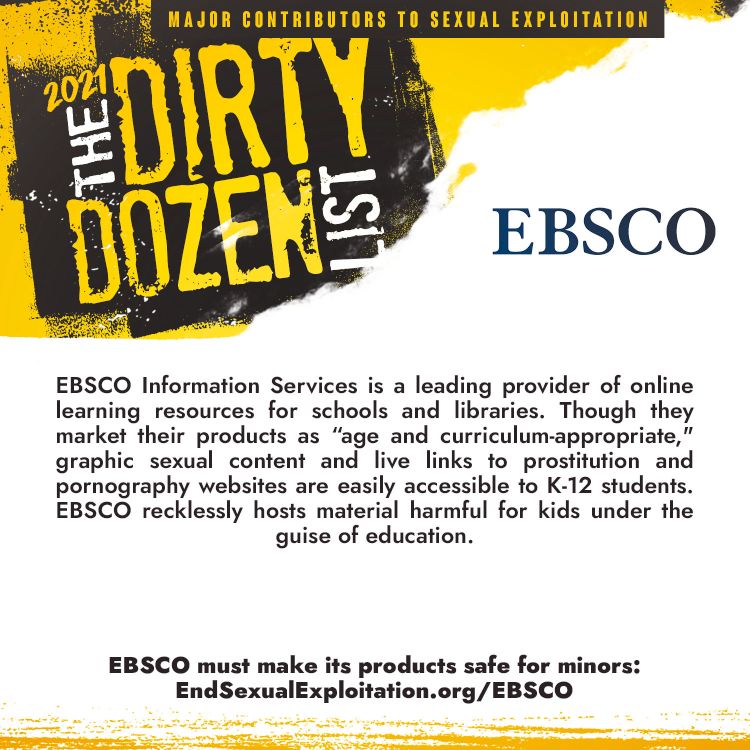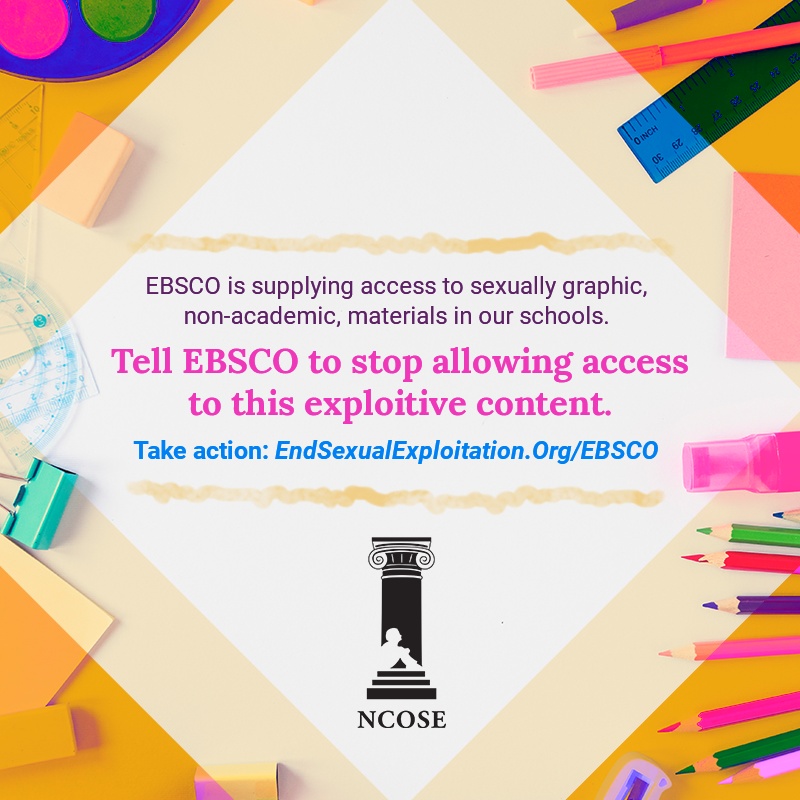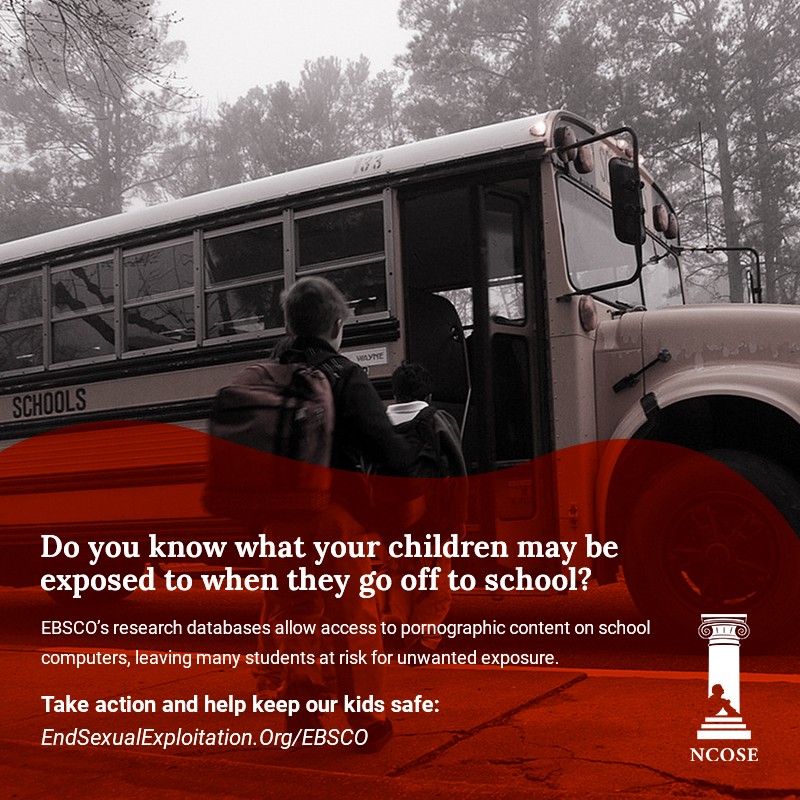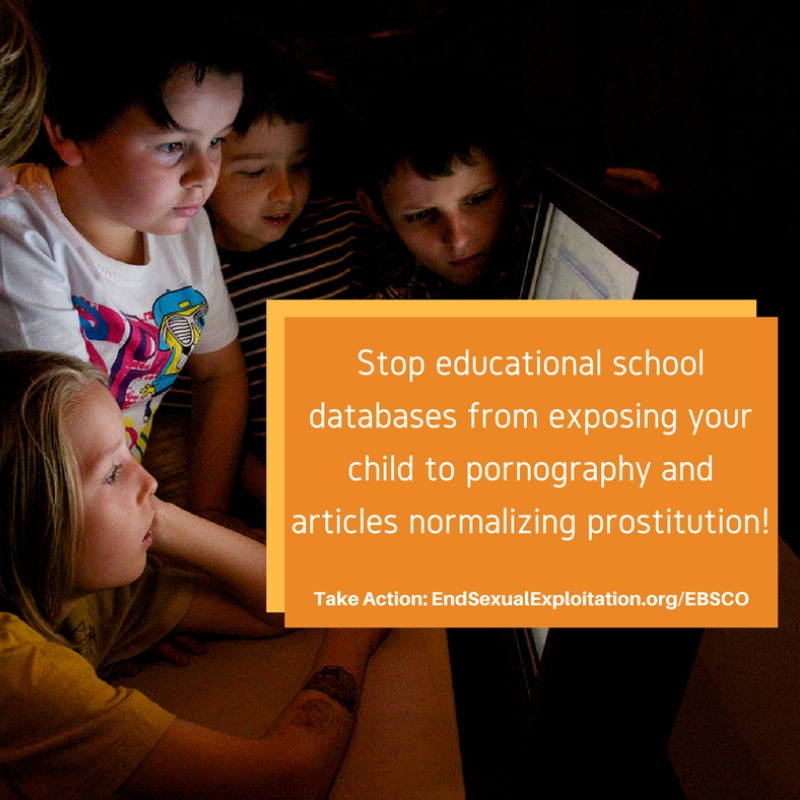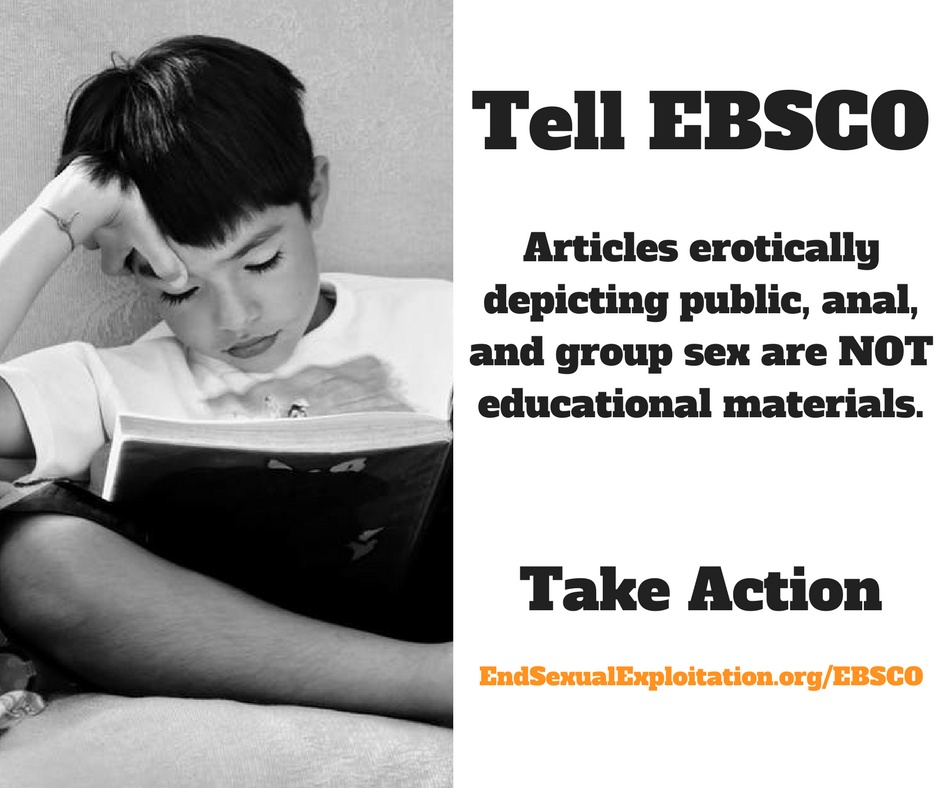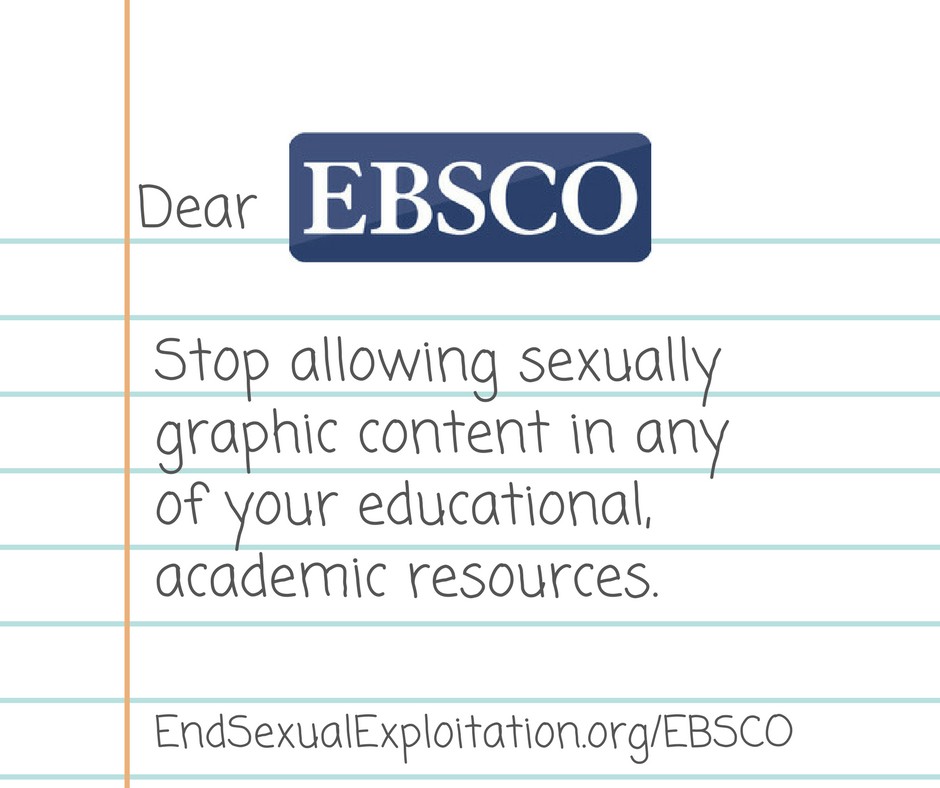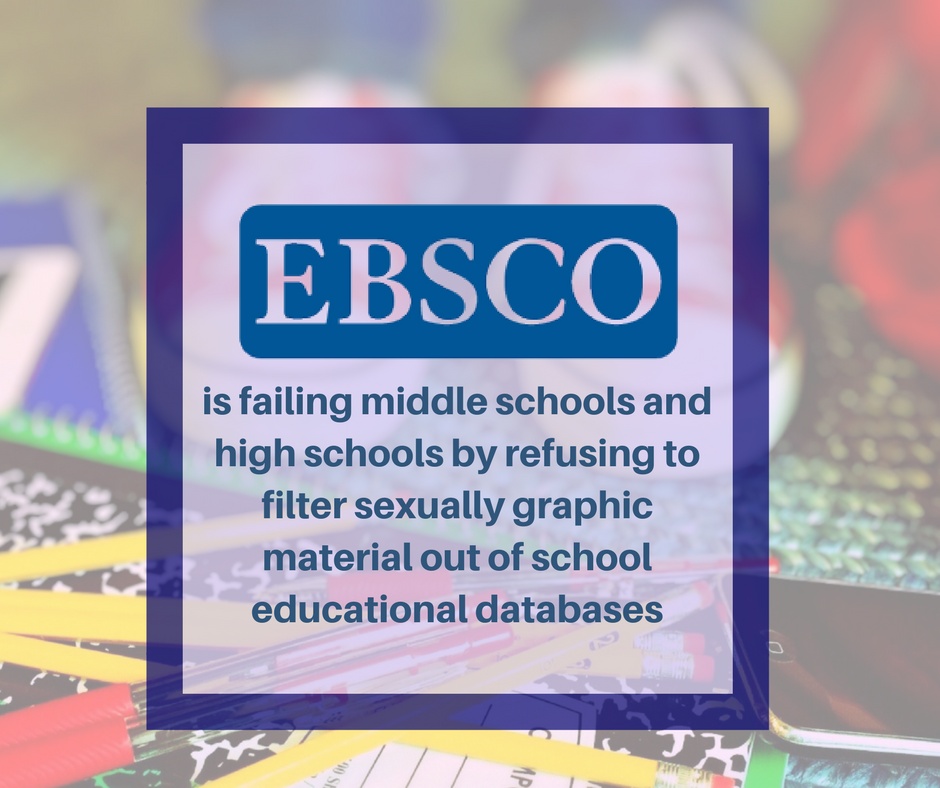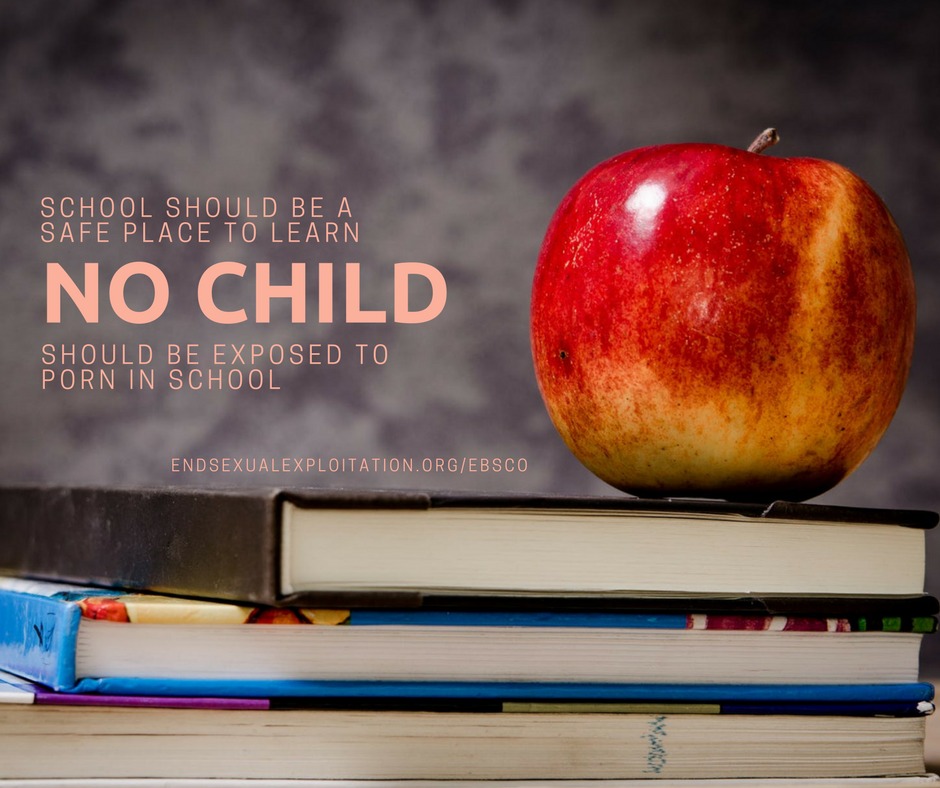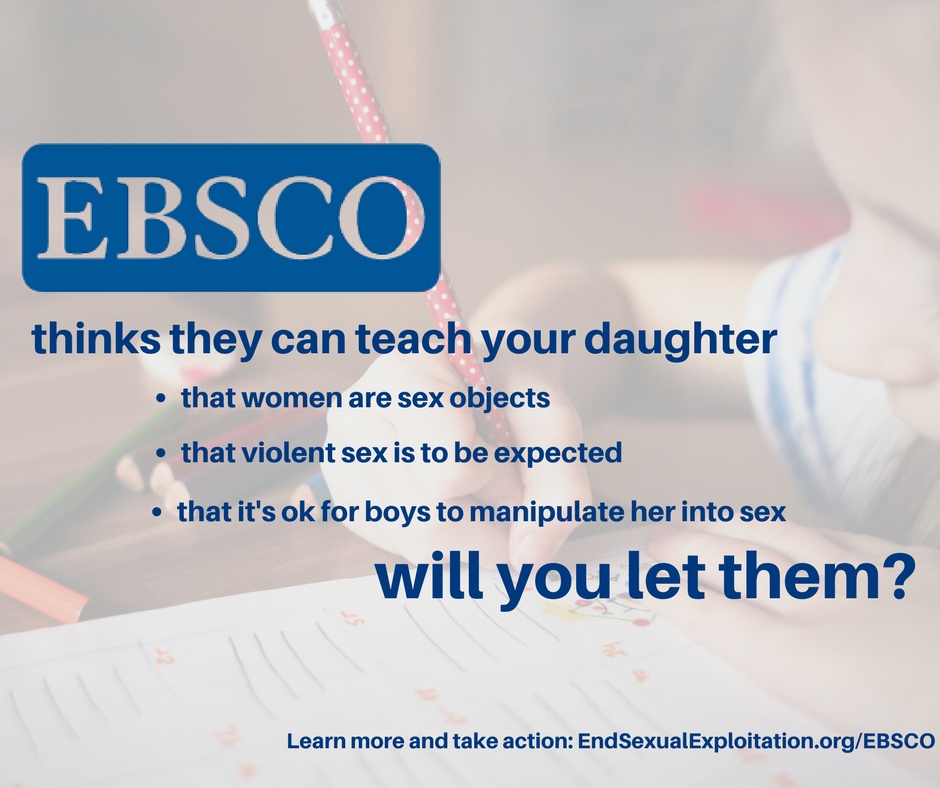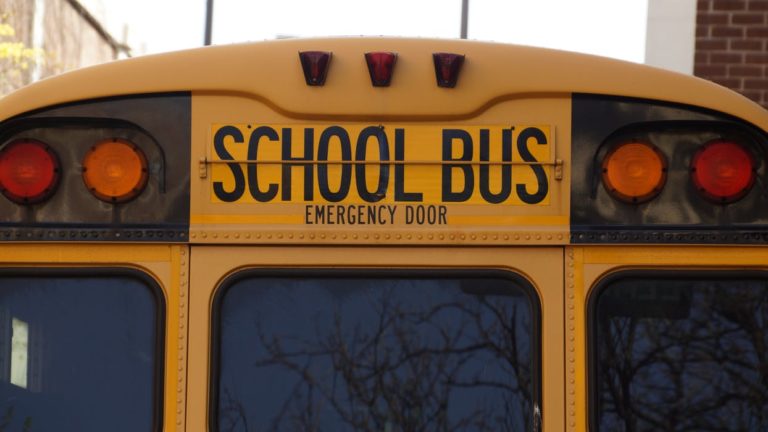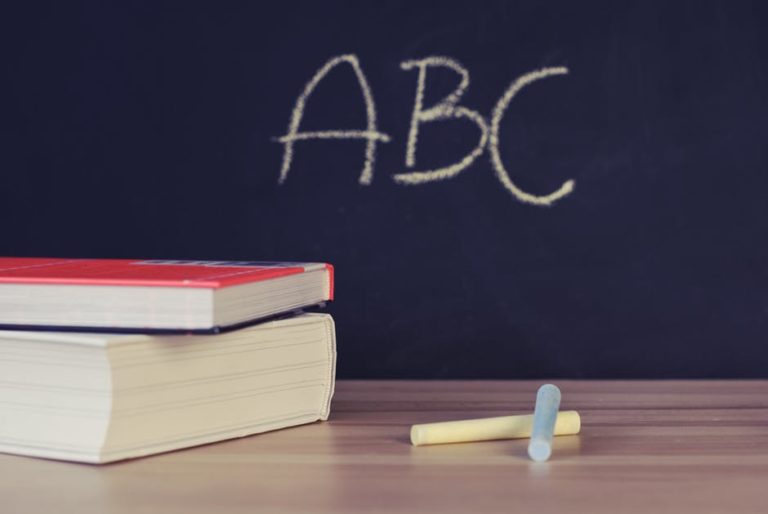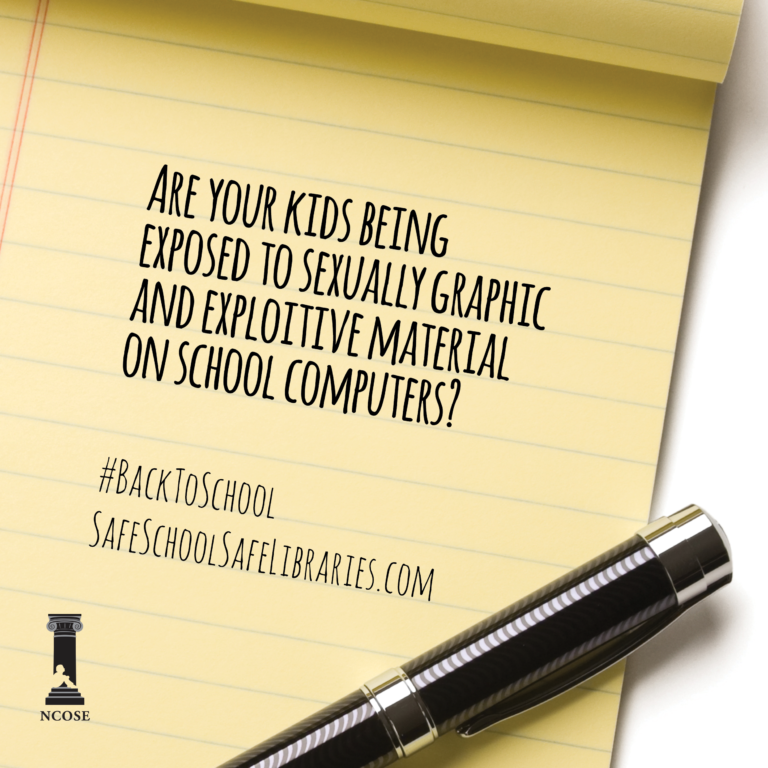
The Problem
In October 2020, EBSCO sent a letter to NCOSE disputing the existence of sexually graphic content on their platforms, despite repeated outreach from NCOSE and provided proof. Their letter and our response are viewable here:
EBSCO Information Services offers online library resources to public and private schools (K-12), colleges and universities, public libraries, and more. In its advertising for schools, it promises “fast access to curriculum-appropriate content.” However, its Explora, Science Reference Center, Literary Reference Center, and other products, sometimes provide easy access to hardcore pornography sites and extremely graphic sexual content.
As part of our ongoing advocacy efforts to hold EBSCO accountable and to educate parents of the increased risk of exposure to harmful materials through school-provided resources during COVID-19, NCOSE published a blog on September 1, 2020, Corporations in the Classroom: What are Google and EBSCO teaching our kids? The blog included several calls to action, including emailing EBSCO asking them to remove pornography and sexually explicit material from databases accessed by minors.
Almost two months later, NCOSE received a “cease and desist” letter from EBSCO’s legal counsel. See the letter from EBSCO and our response here.
Notable Progress:
We want to acknowledge that EBSCO has made significant progress over the last two years, particularly in educational databases meant for elementary students and also in those meant for middle school students. Just two years ago basic searches for innocent search terms like “7th grade biology” or “respiration” would yield results with pornographic images or explicit instructions on risky sex acts. Now, searches for even pornographic terms often yield no result in these databases. We are grateful that EBSCO took on constructive criticism from the National Center on Sexual Exploitation, and others, to address those problems.
Continued Problems:
Unfortunately, there is still sexually explicit content on EBSCO databases marketed to schools as safe and curriculum appropriate.
We also remain concerned that EBSCO places most of the responsibility for removing such content on school and library administrators, yet EBSCO doesn’t adequately warn these administrators that the content is available so easily on its systems.
Some of this material has direct links to hardcore pornography websites staying within the EBSCO database bypassing school filters. The presence of such explicit material in a platform meant for children and teenagers to use while at school or for homework, sends a particularly damaging message to young people that the behavior featured (examples include: group or hook-up sex, incest, “sugar dating” and prostitution in order to pay for college) is normal and expected adult behavior.
On June 23rd 2017, EBSCO wrote to NCOSE saying they were ‘confident’ the sexually graphic content was completely removed from their school products, but on June 26th NCOSE researchers found over 50 sexually graphic articles across 4 states in 50 minutes of searching. The vast majority of these graphic results came directly from EBSCO’s middle school and elementary school databases.
See Our Requests For Improvement
Key Issues EBSCO Must Address:
- NCOSE recognizes improvements within the high school databases. However, NCOSE researchers have still found sexually graphic written content on high school databases, including sexually graphic written descriptions and instructions for oral sex and other sexual acts. While age-appropriate academic articles and research on issues of sexuality are important to include in high school educational databases, the nature of some articles are salacious and not academic. Is EBSCO intending to remove non-academic written depictions of sex acts from its high school databases?
In a statement on September 27, 2018, EBSCO said that it is working to “ensure that questionable content does not appear in [EBSCO’s] elementary, middle school, and high school databases.” While EBSCO has made progress in elementary and middle school databases, there is still more work to be done in high school databases. Far from merely “questionable,” these kinds of articles are clearly salacious and not academic in nature.
- It appears that links and tags within high school databases are able to bring students out of their assigned, age-appropriate, database without warning. This can expose them to more graphic content, as this material is still prominent in other EBSCO databases. Is EBSCO intending to address this loophole in its system?
- Schools still bear the onus of responsibility to ensure students are confined with the database appropriate for their age. In a statement by EBSCO on September 27, 2018, EBSCO notes that “schools [must] make only the appropriate databases available to their students…]” Whether through schools or libraries, children are often able to go from an elementary database into a high school or other less secured databases. Is EBSCO willing to work more proactively with libraries and schools to ensure they are only purchasing or accessing the correct databases and warning them that if they use or purchase other databases the material within is not going to be age or curriculum appropriate? We understand that EBSCO often sells products to the state or to community libraries, and then schools access databases secondarily, and so this is a complex system. But we are asking EBSCO to prioritize the end-user of its school systems—children and teenagers—and to create both better technical and customer service solutions to resolve this on-going problem.
More About EBSCO
Screenshot from EBSCO’s website explaining who they are:
EBSCO Information Services claims to have the user’s needs right at the center of their business model, yet they have routinely misled parents, schools, and libraries regarding the services they provide to users in grades K-12. EBSCO markets their elementary, middle school, and high school online library products as age-appropriate and as having content cultivated for these age groups, yet their technology relies on Lexile measurements to determine how to filter content.
What is Lexile?
Lexile is a scale that helps to evaluate the reading level of material by using quantitative methods based on individual words and sentence lengths, rather than a qualitative analysis reflecting factors such as multiple levels of meaning or maturity of themes. Lower Lexile scores reflect easier readability for books and lower reading ability for readers. (More here.)
How are they getting away with this?
NCOSE didn’t even believe that this was true when we first heard about it! It seemed unbelievable that a company priding itself on providing content to children and creating strong user experiences with customizable services would be so irresponsible and that schools would allow it. Yet, for years, this has seemed to go unnoticed, becoming progressively worse. Also, most parents have no idea that this is happening! #1) They aren’t used to using these kinds of databases themselves. #2) They assume that these are age-appropriate just as EBSCO and the schools are suggesting. #3) Many schools are actually telling parents not to use their child’s logins to the system. The parent logins don’t contain all of this material.
What about the schools?
We hope that the schools themselves would be open to fixing this problem! The goal of this campaign is to help educate our school officials and empower them to also demand change.
However, NCOSE has heard of teachers in Colorado bringing these issues to the attention of school administrators. These teachers’ concerns and suggestions to at least alert the parents have been routinely dismissed. One school district in Colorado, Cherry Creek School District, is defending much of the content brought to their attention, even though it is promoting behaviors such as public, group, and torture sex and includes direct live links to hardcore pornography websites. The school administrators are also arguing that they are not responsible since it is coming from a third party provider, EBSCO, even though the schools are the ones promoting these resources to their students.
More about EBSCO:
EBSCO Information Services is a division of EBSCO Industries, with annual sales in 2013 of nearly $2 billion. EBSCO offers library resources to customers in academic, medical, K–12, public library, law, corporate, and government markets. They have created the following products supposedly just for these age groups: Primary Search for Elementary Schools, Middle Search Plus for Middle Schools, and MAS Ultra for High Schools. EBSCO also recommends the following products for K-12 ages through their website and many K-12 schools subscribe to these services as well: Explora, NoveList, Science Reference Center, Consumer Health Reports, Poetry and Short Story Reference Center, among others.
From what NCOSE has been able to determine, school districts are either contracting directly with EBSCO for these products or they are getting them through an agreement with their state or county library systems.
With the help of concerned parents around the U.S. and Canada, NCOSE has ascertained that each of these specially designed products are categorically filled with soft pornography, links to hardcore pornography, sexually explicit written descriptions, and advice and tutorials normalizing and glamorizing risky sexual behaviors. Themes of BDSM, or torture sex, seem to flood all of the products and we found articles glamorizing sexual relationships between students and teachers; eroticizing sexual violence and rape; and encouraging children to view pornography in order to learn more about sex.
What about school filters?
While most schools have filters on the school’s computers or wifi (although often not good enough or installed correctly), such filters are not enough to solve this problem. School filters may stop the access of the hardcore pornography websites linked to from within the EBSCO database because they open up in a regular browser. This would only apply if the user were using the database while at school. We hear that students are often assigned homework using material in these databases and so are likely not always using filtered Internet. Additionally, even if not going directly to the porn website, the students are still seeing the URL within EBSCO and bombarded with the explicit language around those lists of porn websites.
Other than blocking the content linked to outside of EBSCO, the school filters do not block within EBSCO on their own as the whole system, EBSCO, has been given a green light to not be filtered. So, the hundreds of pornographic and explicit articles, books, magazines, and photographs housed within the EBSCO database are fully available to K-12 users. It appears to NCOSE, based on asking questions which quickly led administrators to stop speaking to us, that the schools have some ability to block out some content through the EBSCO system, however, they have to go in and do so one-by-one and essentially are doing very little of this.
What are the harms?
NCOSE is especially concerned that young children are exposed to such material through irresponsible business and filtering practices. At a time when many are recognizing the public health impacts of pornography, especially to the developing brain and adolescent psychological, physical, and social development, we must not rely on parents alone to fix all of this.
The harms of pornography are well documented. For instance, a growing body of neuroscience reveals that adults are developing addictions to pornography as pornography hijacks the brain’s reward center in a way similar to drug addiction.[1] A nationally representative online survey of 3,000 people reveals that nearly half of young people (ages 13-24) actively seek out pornography weekly or more often.[2] This is especially troubling given that research shows that adolescents are more susceptible to forming addictions than adults because the dopamine neurons in their nucleus accumbens (i.e. the brain’s pleasure center) are much more active and have an exaggerated plasticity in response to addictive stimulus.[3] Thus, it can be said that a propensity for addiction is more strongly “hardwired” into the adolescent brain.[4]
A recent survey found that 27% of young adults report first viewing pornography before puberty.[5] This is alarming given that Internet pornography consumption by adolescents is associated with risky sexual behavior (that can have profoundly adverse effects), such as anal and group sex, hookups, multiple sexual partners, and substance use during sex.[6] (Articles via the EBSCO databases to middle schoolers glamorized all such behaviors).
Such outcomes are not surprising in light of how the human brain develops. Research shows that adolescents are not as readily able as adults to access their frontal lobes—the portion of the brain that controls impulses and allows for rapid, smart decision making.[7] Moreover, multiple neurological studies contribute to the view that pornography use interferes with “working memory” performance, thus inhibiting the judgment and decision making functions of the prefrontal cortex.[8]
Moreover, pornography is linked to sexual violence among adolescents and adults. A nationally representative survey of pornography use among youth aged 9–17 found that those with increased exposure to Internet pornography were significantly more likely to report physical and sexual victimization.[9] A separate study of 14- to 19-year-olds found that females who watched pornographic videos were at significantly greater likelihood of being victims of sexual harassment or sexual assault.[10] A study of 804 Italian males and females aged 14 to 19, found that males who viewed pornography were significantly more likely to report having sexually harassed a peer or forcing someone to have sex.[11]
Building on the link between pornography-abuse and sexual violence, a recent meta-analysis of 22 studies from seven countries provides clear evidence confirming that pornography exposure is significantly associated with sexual aggression.[12] As the authors state, “the accumulated data leave little doubt that, on the average, individuals who consume pornography more frequently are more likely to hold attitudes conducive to sexual aggression and engage in actual acts of sexual aggression than individuals who do not consume pornography or who consume pornography less frequently.”[13]
Further, older adolescents who use pornography are more likely to be attracted to 13- or 14-year olds,[14] and the earlier college men were exposed to pornography the more likely they are to have engaged in nonconsensual sex.[15] Fraternity men who consumed mainstream pornography expressed a greater intent to commit rape if they knew they would not be caught than those who did not consume pornography. Those who consumed sadomasochistic pornography expressed significantly less willingness to intervene in situations of sexual violence, greater beliefs in rape myths, and greater intent to commit rape. In addition, among those who consumed rape-themed pornography, the researchers described “serious effects” including less bystander willingness to intervene, greater belief in rape myth, and greater intent to commit rape.[16] In other words, there was no type of pornography that did not result in a greater intent to commit rape by a user if they knew they would not be caught.
Today, pornography is pervasive and it is damaging countless lives. Its role in shaping the attitudes and behaviors that fuel the crisis of sexual assault on college campuses, sexting scandals, revenge pornography, sex trafficking, child sexual abuse, compulsive pornography consumption, and more is clear.
Special Thank you
NCOSE wants to thank Robin and Drew Paterson for their unwavering courage and commitment to providing a safe space for their child and all school-aged children. These concerned parents exposed this problem of EBSCO providing access to hardcore pornography, softcore pornography and glamorizing risky sexual behavior to students as young as elementary school. They first alerted school officials in their local district, but when that was met with the complete dismissal of their concerns, they started trying to raise awareness much broader. They researched other school districts and found the same material there; contacted EBSCO directly who admitted to this problem but said not much could be done; and then started reaching out to the media and advocacy groups.
NCOSE also recognizes and thanks Mass Resistance for giving the Paterson’s a platform to expose EBSCO’s practices. They were the catalyst for many concerned groups and activists to join together in addressing this problem.
[1] Simone Kühn and Jürgen Gallinat, “Brain Structure and Functional Connectivity Associated with Pornography Consumption: The Brain on Porn,” JAMA Psychiatry 71, no. 7 (2014): 827-834. Ji-Woo Seok and Jin-Hun Sohn, “Neural Substrates of Sexual Desire in Individuals with Problematic Hypersexual Behavior,” Frontiers in Behavioral Neuroscience, (November 30, 2015). Porn Study Critiques, “Current List of Brain Studies on Porn Users, (September 29, 2015) http://pornstudycritiques.com/current-list-of-brain-studies-on-porn-users/ (accessed February 4, 2017).
[2] Barna Group, “The Porn Phenomenon: A Comprehensive New Survey on Americans, the Church, and Pornography,” (2016).
[3] Frances E. Jensen with Amy Ellis Nutt, The Teenage Brain: A Neuroscientist’s Survival Guild to Raising Adolescents and Young Adults, (New York: Harper Collins, 2015).
[4] Ibid.
[5] Barna Group, “News Conference on Barna’s New Study: ‘The Porn Phenomenon,’” (January 15, 2016) https://www.barna.org/blog/culture-media/barna-group/porn-press-conference#.VrS9OrSJndl, (accessed Febraury 4, 2017).
[6] Debra Braun-Courville and Mary Rojas, “Exposure to Sexually Explicit Web Site and Adolescent Sexual Attitudes and Behaviors 45 (2009): 156-162.
[7] Frances E. Jensen with Amy Ellis Nutt, The Teenage Brain: A Neuroscientist’s Survival Guild to Raising Adolescents and Young Adults, (New York: Harper Collins, 2015).
[8] C. Laier, F.P. Schulte, and M. Brand, “Pornographic Picture Processing Interferes with Working Memory Performance,” Journal of Sex Research 50, no. 7 (2013): 642–652; C. Laier, M. Pawlikowski, and M. Brand, “Sexual Picture Processing Interferes with Decision-Making under Ambiguity,” Archives of Sexual Behavior 43, no. 3 (2014): 473–483.
[9] Michele L. Ybarra and Kimberly Mitchell, “Exposure to Internet Pornography among Children and Adolescents: A National Survey,” CyberPsychology & Behavior 8, no. 5 (2005): 473–486.
[10] Silvia Bonino, Silvia Ciairano, Emanuela Rabagliette, and Elena Cattelino, “Use of Pornography and Self-Reported Engagement in Sexual Violence among Adolescents,” European Journal of Developmental Psychology 3, no. 3 (2006):265-288.
[11] Silvia Bonino, Silvia Ciairano, Emanuela Rabagliette, and Elena Cattelino, “Use of Pornography and Self-Reported Engagement in Sexual Violence among Adolescents,” European Journal of Developmental Psychology 3, no. 3 (2006):265-288.
[12] Paul J. Wright, Robert S. Tokunaga, and Ashley Kraus. “A Meta-Analysis of Pornography Consumption and Actual Acts of Sexual Aggression in General Population Studies.” Journal of Communication, (December 29, 2015): 1-23.
[13] Ibid.
[14] Kristinn Henga, Svein Mossige, and Lars Wichstrom, “Older Adolescents’ Positive Attitudes toward Younger Adolescents as Sexual Partners,” Adolescence 39, no. 156, (2004): 627-651.
[15] Mary Anne Layden, unpublished data, 2015.
[16] John Foubert, Matt Brosi, and R. Bannon, “Pornography Viewing among Fraternity Men: Effects on Bystander Intervention, Rape Myth Acceptance & Behavioral Intent to Commit Sexual Assault, Sexual Addiction & Compulsivity, 18, no. 4 (2011): 212-231.
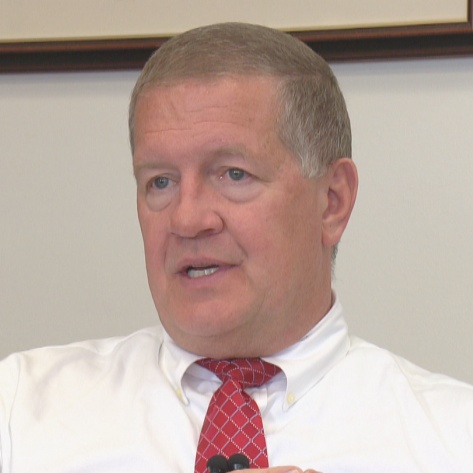
There are some articles in there that I don’t know that middle school kids need to be reading.
Harry Bull
Cherry Creek Superintendent

My reaction to this is absolutely not appropriate for use in our schools. As soon as we became aware of this we shut the system down.
Priscilla Straughn
Chief Academic Officer, Adams 12 Five Star School District
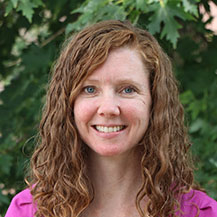
Cherry Creek Schools worked with EBSCO for about one year to prevent objectionable content from being accessed through the database and tighten search filters, but the district was not satisfied with the result.
Abbe Smith
Cherry Creek Schools Spokesperson
WARNING: Any pornographic images have been blurred, but are still suggestive. There may also be graphic text descriptions shown in these sections.
POSSIBLE TRIGGER.
Proof
2019 Proof
Included below is a sampling of screenshots providing concrete illustrations of how EBSCO has consistently failed to provide age-appropriate content to its youngest users.
In EBSCO’s Explora products, there are still live links to pornographic websites. These images were captured in October 2018.
Due to the graphic nature of the descriptions & images found in this proof, we've compiled them into a PDF document that you can download here.
Primary Search (Elementary) (2017)
EBSCO has designed an Elementary School database, called Primary Search.
From EBSCO's marketing of the product, many school districts and parents are led to believe that the content is already filtered to be age-appropriate. This system has pornography available, as well as links to hardcore pornography websites - all of which are not caught by school or home filters as the filters are set to allow access to everything through EBSCO. In addition, much of the sex ed material teaches essentially that anything goes between ages 5-11.
Sample of Material from June 2017 (after EBSCO claims the Primary Search product has been completely cleaned)
Due to the graphic nature of the descriptions & images found in this proof, we've compiled them into a PDF document that you can download here.
Middle Search Plus (Middle School) (2017)
EBSCO has designed a Middle School database, called Middle Search Plus, and categorically loaded it with porn links, as well as advice to engage in risky sexual behaviors. They have falsely marketed the product as "designed for middle school libraries" leading subscribers to believe the content is age-appropriate.
Due to the graphic nature of the descriptions & images found in this proof, we've compiled them into a PDF document that you can download here.
MAS Ultra (High School) (2017)
Due to the graphic nature of the descriptions & images found in this proof, we've compiled them into a PDF document that you can download here.
Explora (2017-18)
Due to the graphic nature of the descriptions & images found in this proof, we've compiled them into a PDF document that you can download here.
Science Reference Center (2017-18)
Due to the graphic nature of the descriptions & images found in this proof, we've compiled them into a PDF document that you can download here.
Novelist (2017-2018)
Due to the graphic nature of the descriptions & images found in this proof, we've compiled them into a PDF document that you can download here.
Consumer Health Reports
Due to the graphic nature of the descriptions & images found in this proof, we've compiled them into a PDF document that you can download here.
Poetry and Short Story Reference Center
Due to the graphic nature of the descriptions & images found in this proof, we've compiled them into a PDF document that you can download here.
Take Action
Check Your Local School’s Online Databases
Safe Schools, Safe Libraries
Public Health Harms of Pornography
Pornography In Our K-12 Schools
Share Your Story
Have your kids been exposed to pornography and sexual exploitation on school computers?
Help educate others and demand change by sharing these on social media:
Updates
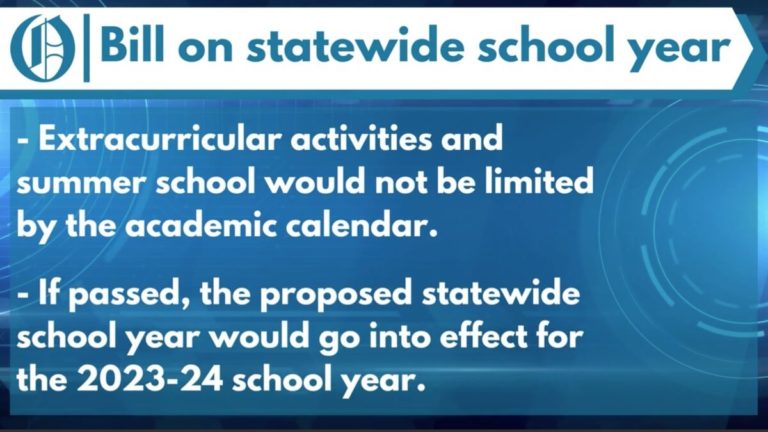
Bill aims to block Nebraska students from accessing obscene materials
Read this Article from the Omaha World-Herald
February 21, 2022




